Cryptosporidium Removal, Occurrence, and Inactivation Methods for Wastewater
BücherAngebote / Angebote:
Treatment of drinking water was once considered sufficient for reducing the risk of infection from pathogenic organisms. However, as our knowledge of established and emerging pathogens in water has expanded, so has the need to examine their occurrence, distribution, risk to humans, and control through treatment. The increased need for wastewater reuse has resulted in attention now being focused on wastewater treatment processes and their ability to reduce the numbers of pathogenic organisms to acceptable levels. A public health concern with wastewater is the potential for transmission of infectious agents that may be present in human and animal feces. Depending upon the diseases in the contributing communities, sewage can contain varying numbers of pathogenic organisms including viruses, bacteria, helminths, and protozoa. This study focused on one pathogen, Cryptosporidium parvum, and its occurrence in wastewater. In order to conduct an occurrence study, it was firstly necessary to develop methods for recovery of Cryptosporidium oocysts from wastewater matrices. Due to the differences in matrix composition from raw sewage to tertiary effluents, different methods for recovery and enumeration of oocysts were developed based on matrix quality. A single method was developed for raw sewage and primary influents, a second method for secondary and tertiary effluents, and a third method for biosolids. These methods were used in a survey of Cryptosporidium occurrence at 10 wastewater plants in the U.S. over a 15-month period. To determine if oocysts found in wastewater samples represented a public health risk, cell culture methods were employed to examine infectivity of recovered oocysts.
Folgt in ca. 15 Arbeitstagen




